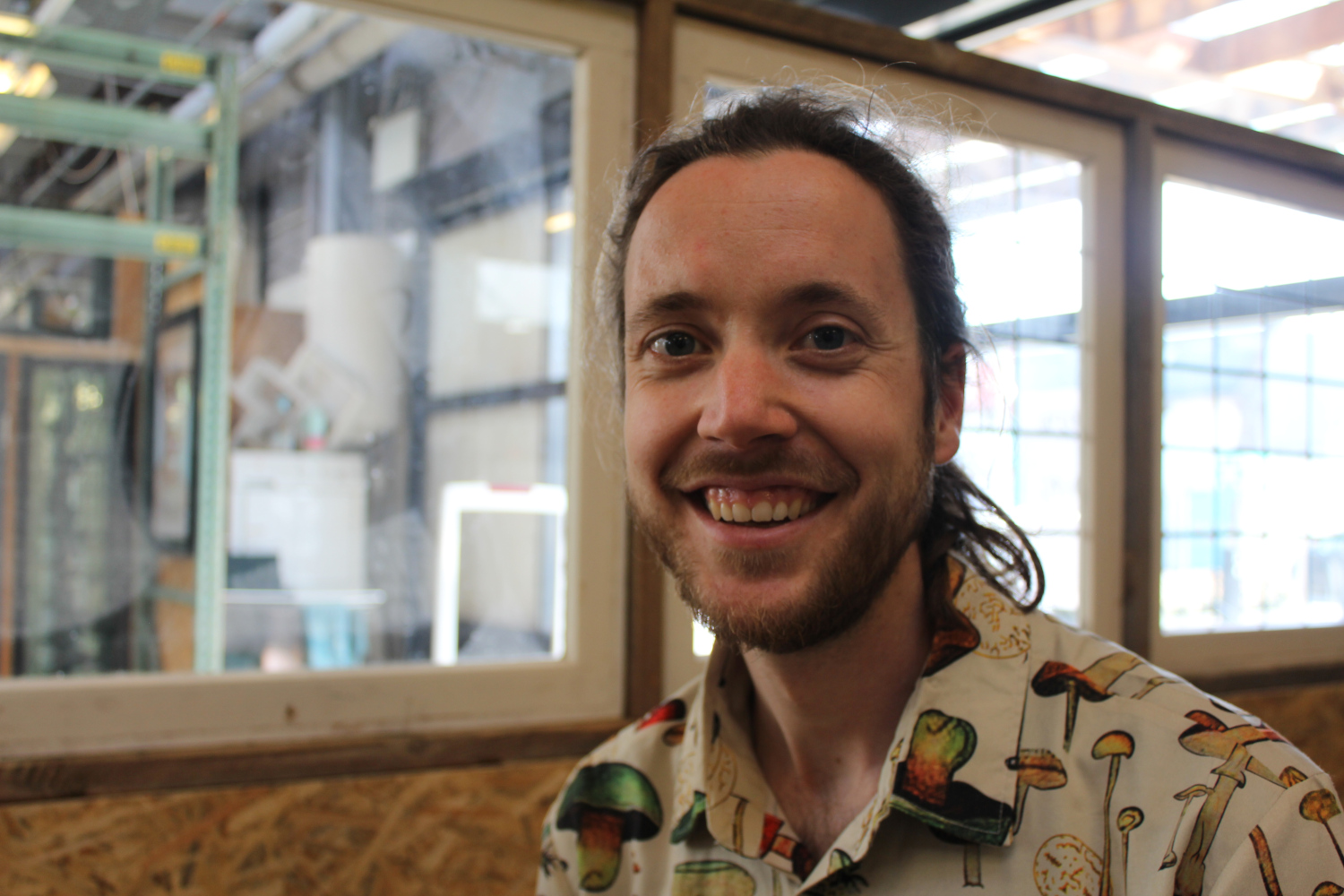Reinier Boon has his company on the site of the Nettenfabriek on the Spoorstraat in Apeldoorn mushroom man established. From here he gives workshops and sells stuff to grow mushrooms himself. He conducts research and fieldwork to deepen and broaden his knowledge. Reinier lives with Tim ‘off-grid’ in a tiny house in Klein Zuidbroek
How did you come into contact with the world of mushrooms?
“Once upon a time, I was on the internet watching some YouTube videos. A video of mycologist Paul Stamets came by. He told how fungi could save the world through all kinds of applications. I was so overwhelmed by that and then searched all over YouTube for everything about fungi. After that I really went into nature to see them and get to know them.”
“The fungus is the mycelial network that is located underground and in trees”
What fascinates you about the mushroom?
“The mushroom as we usually encounter it is actually the fruit body of the fungus. The fungus is the mycelial network that is located underground and in trees. The amazing thing about such a fungus is that you don’t see it, but exchange nutrients and communicate with each other in collaboration with plants and trees. The mushroom is the part of the organism that we actually see and is a wonderfully beautiful display of the network that you then don’t see.”
Born: January 29, 1987
Parents: Henk and Marianne
Brothers Sisters: Marjolein and Heidi
In love, engaged, married: married to Tim
Most proud of: Our little house
Gets inspired by: mushroom network (the mycelium)
Hate: inequality
loves: mushrooms and bad jokes
What book is on your nightstand: Entangled Life – Merlin Sheldrake
What may they wake you up at night for: super clear night with galaxy
Webiste: paddenstoelenman.nl
Instagram: @mushroomman
–
For most it stops at the mushroom and the chanterelle. Where and how did you get your knowledge about the mushroom?
“I gained my knowledge in two ways. First off, just go wild on the internet to gather all the knowledge. I read less quickly so I mainly focused on visual material. Then I delved into all the books that were recommended to read. Most importantly, what I’m also doing here with the Mushroom man, is teaching people how to grow mushrooms at home. You really have to observe to learn how the mushroom grows, what the best growing conditions are, the substrate it grows on. You only gain this specific knowledge by actually working in the forest and by observing accurately. To sit down and look around to see what is happening. A lot of research is being done and recent results into the underground networks in which plants and trees are interconnected and thus communicate with each other. This is called the Wood Wide Web, the internet of the forest.”
“And in my environment I feel that mushrooms and fungi are the future”
How do you find such a network?
“It’s everywhere. If we look at how a mushroom reproduces. From the mushroom, the fruit body, all microscopic spores fall, which whirl through the air and are carried with the wind or excreted through the body when consumed and so they spread everywhere. As we sit here now and we take a deep breath, we have ingested quite a number of different fungal spores. They can settle anywhere and form a new fungus on surfaces where they feel comfortable. Often a moist wet soil where they can germinate well.”
Interest in mushrooms is one thing, but growing it into a company is another. How did that process go?
“That’s very exciting. The Mushroom Man as a company has been around since December 2021. I made this choice because I could no longer connect with my previous work. It also has to do with the fact that I have started to organize my lifestyle differently. Much more in the direction of nature. I am now in the position that my fixed costs are very low and I dared to take the plunge. Made a calculation where it should be possible. And in my environment I feel that the mushrooms and fungi are the future. That gives me hope that the Mushroom Man will succeed.”
“Another special application is improving insulation material”
In which areas does the mushroom find its application?
“Consumption is one of the most well-known ways in which mushrooms are used. Think of the mushroom and the oyster mushroom. They are not only super tasty but also super healthy. For example, oyster mushrooms contain vitamin D, which is necessary for many people, especially in winter. And a fungus that also occurs in winter. A natural source of vitamin D. The shiitake mushroom contains vitamin B12. In my workshops I learn how people can grow mushrooms themselves in order to leave nature alone. My strength is transferring knowledge and teaching people how to grow mushrooms themselves. A second nice application is the use for health. These agents exist in dried form or fresh. Or in the form of tinctures, the active substance of which is obtained with alcohol. In addition, you have the magic mushrooms, popularly called ‘mushrooms’ and are used in the treatment of depression, anxiety and PTSD, among other things. The most striking example from the medical world is the use of penicillin, also a fungus, discovered by accident by Alexander Fleming. Another special application is the improvement of insulation material. A company is developing insulation material for the fungus using the mycelium network. Super light material.”
A question appropriate to this time: what’s in it for me?
“I’d say it’s good for your health. For example, the fairy bench can be used to boost your immune system and contribute to recovery after radiation.”
“We expect there to be about 5 million different fungi, of which only a few tens of thousands are classified”
How long have you been working with the mushroom?
“I came into contact with the work of Paul Stamets 7 years ago and have since developed myself further. I went outside and started growing my own mushrooms. I also got acquainted with the magical mushrooms and encouraged me to delve even further into the matter.”
Mushroom is a collective name. Which types can you distinguish and what are they used or not used for?
“We expect that there are about 5 million different fungi, of which only a few tens of thousands are classified and several dozen of them are used by us and an even smaller number are grown on a large scale. For example, there are fungi that can only exist in a symbiotic relationship with a tree or a plant. That is why it is so important to observe in nature.”
I read that you work as a software developer. Where did the choice for this profession come from at the time?
“Very simple really, I had two things in mind, one of which was a software developer. My father said: ‘So there is a big shortage of IT staff. if you want job security, you have to become an IT professional. I liked computers, so I started doing it. Enjoyed doing it for years. But slowly I noticed that I had to go more in the direction of nature.”
Owning your own business takes a lot of time and energy. How do you maintain the balance between work and relaxation?
“A lot of time, a little less present at the net factory, but in nature I am very busy photographing, observing and enjoying at number one. It really is a fantastic passion that I wake up with every day and go to sleep with. A favorite place for me In Apeldoorn is the Woudhuizerbos. Furthermore, I generally visit smaller forest areas where the forest is left alone for a while. Now that I’m still in the start-up phase, I notice that a lot of energy is going into it.”
What will your business look like in 5-10 years?
“For the first 5 years I want to develop myself so that the Mushroom Man becomes a household name, at least in Apeldoorn and the region. Develop the education side further with mushroom walks, deepening and enriching the workshop offer. Providing information in schools about the importance and significance of fungi.
After 10 years, expanding with research into multiple applications, which can be used both on a small-scale and on a large scale. For example, how you could clean soil contaminated with fungi. Ultimately, I hope that when I am very old, a lot of people in the Netherlands and the surrounding area and they talk about mushrooms, will say: ‘Then you should go to the Mushroom Man, you will learn more from it’.”
–


